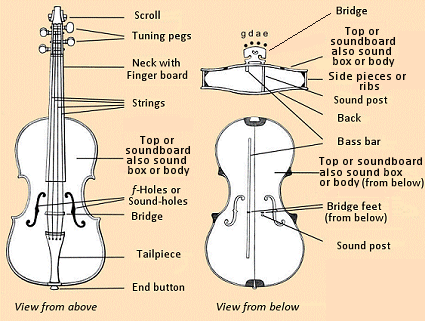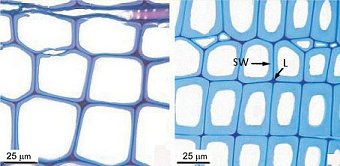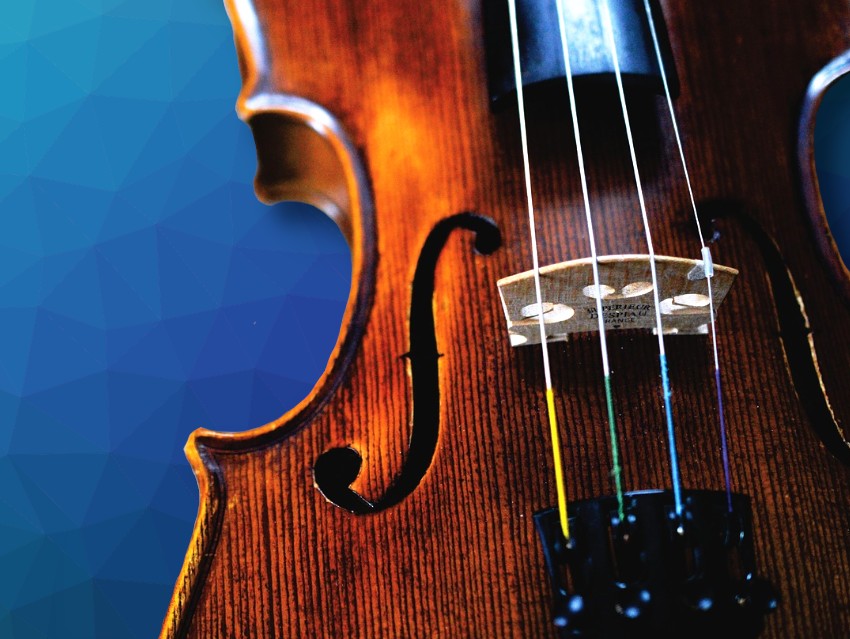In the first part we looked at physical measurements to come somewhat closer to the secret of the Stradivarious. In what follows, we consider from a chemical point of view those components of a Stradivarius that are the principal sources of its sound characteristics, in hopes of perhaps coming a bit closer to Stradivari’s secret.
4. Components Responsible for the Sound of a Stradivarius, from a Chemical Perspective
4.1. Wood
The body of a violin consists exclusively of wood: spruce for the top or soundboard, and maple for the ribs, the bridge, the back, the bass bar, and the sound post.

Figure 4. Components and structure of a violin.
Many professionals consider that the secret actually lies in the stellar quality of the wood Stradivari employed. From a chemical point of view, wood is a composite material composed of the three polymers cellulose, hemicellulose, and lignin and with an internal honeycomb structure, the mechanical properties of which (elasticity, strength, etc.) are a function not only of the type of wood, but also the climatic conditions it experienced during its growth phase.
As a tree grows in girth in the springtime, the cells added are short and thin-walled, and they have a large inner diameter to facilitate water transport (earlywood; Fig. 8, left). Latewood, by contrast, is characterized by long narrow cells whose lamellae (L) are thickened with a secondary wall (SW) for fortification of the wood (Fig. 8, right). If the summer weather is cold and moist, the annual rings that form are narrow, and consist mainly of large inner-diameter earlywood cells, and the corresponding latewood shows only thin secondary walls [8].

Figure 8. Cells for the transport of water in earlywood (left) and latewood (right).
Stradivari utilized alpine spruce for his tops, and maple from Bosnia for the sides and backs. He paid very close attention to the quality of the wood, and had the “good fortune of the proficient” that over a long period of time (1650–1715) his wood came from trees that grew during a prolonged period of low mean summer temperatures—the Maunder Minimum—, also characterized by extreme inactivity with respect to sunspots. The resulting minimal growth of latewood resulted in narrow growth rings and wood that was exceptionally elastic, and at the same time light. These are prerequisites for excellent vibrational characteristics [9].
Present-day violinmakers, of course, are not in a position to grow spruce and maple for 70 years in cold storage, under temperature conditions mimicking those of a Little Ice Age, but resourceful scientists have devised alternative approaches. Since what really matters is minimizing the amount of woody substance associated with secondary walls, wood for this purpose has been treated with hemicellulases that specifically degrade hemicelluloses present [10]. An alternative is inoculation of “normal” wood with selected fungi (e.g., Physisporinus vitreus) that over the course of several weeks carry out their mission of selectively degrading secondary walls [8].
Priming of the Wood
Joseph Nagyvary, a biochemist at Texas A&M University, USA, examined the composition of the wood in old Italian violins [11]. Through use of the EDS (energy dispersive X-ray spectroscopy) technique, he determined the various elements present in ash derived from tiny splinters arising in the course of restoration work. A comparison of maple from various Stradivari and Guarneri instruments with maple available today provided a number of surprises (see Fig. 9).

Figure 9. Elemental composition of ash from the maple of various violins.
4.2. Impregnation
Boron
In addition to the elements shown in Figure 9, boron was found to be present in some of the violins, something that would not normally be a constituent of natural wood. The great differences from instrument to instrument, as well as from modern, untreated wood, points to the notion that the violin wood had been impregnated. Boron had long been recognized as an insecticide and fungicide, and its use would have been sensible as a way of protecting against attack from worms and fungi.
Zirconium
Whereas the content of various heavy metals is suggestive of residues from sandy abrasives or natural pigments, the zirconium sulfate content with the Guarneri is rather odd. Perhaps the puzzle has a very simple solution, however, since in his alchemical tracts, Paracelsus recommended a vaguely defined “gemstone salt” for the tempering of wood. If such a mixture of water-soluble and insoluble salts had been available in Cremona, its application in the course of violinmaking would have been logical. The composition of the “gemstone salt” would have been beyond the control of the violinmaker, and might well have differed from one consignment to the next.
Despite the considerable variance, it is important to take note of the fact that this unusual impregnation seems to have been employed only by the violinmakers from Cremona, and was apparently not repeated later. It is doubtful, however, that Stradivari & Co., in addition to protecting against worms and fungi also deliberately employed this impregnation—the precise composition of which is no longer known—in the interest of sound enhancement.
4.3. Finishing
Independent of possible impregnation, the surfaces of the raw body and other wooden components were subjected to finishing. In general, this is a multistep process through which first a primer and on top of this several varnish coats were applied.
The primer served to fill small cracks and smooth over surface imperfections, after which the surface was sanded smooth. Particles such as plaster, volcanic ash, or minerals and pigments plugged the uppermost non-intact layer of wood cells so that varnish laid down later could not penetrate too deeply into the wood (see Fig. 10). The surface of the Stradivarius in question retains only a very thin varnish coat over a thicker primer, in which many contiguous particles can be seen (left). In one small region of primer, EDAX (energy dispersive analysis by X-ray) was utilized at four different points to establish the elemental composition (see Fig. 10, right). The relatively large variations within this small area of investigation are indicative of considerable heterogeneity in the primer [12].

Figure 10. Scanning electron microscopic cross-section of the surface of a Stradivarius and the elements present.
Light elements (H, C, N, O) are not detected in this approach, so that organic binders such as linseed oil or tree resins, though present in great excess, cannot be directly identified.
Thus, one apparently encounters chiefly an aluminosilicate, followed by iron oxide, and then, third, particles of red realgar (As4S4) or yellow orpiment (As2S3), while fourth place is assumed perhaps by calcium sulfate and copper sulfide crystals.
This chemically confusing situation is readily explained, however, if one begins by assuming a primer of a mineral-pigment dispersion in an organic hardening binder, such as colophonium (rosin) dissolved in turpentine. The specific mixture would have been tailored to the color preferences of the client or the violinmaker, and drawn from the current offerings of a particular supplier. In any event, there is no evidence for a repeatedly utilized “secret recipe” on the part of a given violinmaker.
5. Antonio Stradivari’s Varnish
The varnish of a Stradivarius has been assigned by some an almost supernatural importance, and since formulations in those days were always regarded as family secrets, many have imagined that this varnish represented the true “secret” of a Stradivarius.
A search for the “true” formula was actually driven by the London violin-dealing family Hill, who in their 1902 book Antonio Stradivari, His Life and Work [13] identified three factors as responsible for the tone quality of a violin: 1) materials, 2) dimensions and construction, and 3) varnish.
They then elaborated at great length on the fact that varnish was the most important, and wood quality the least. Experts today regard this as exaggerating the role of varnish quality, since every varnishing results in a weight increase, with an accompanying damping of vibrations [14]. This may be the reason why medieval lute-makers only partially varnished their instruments. It is now recommended that especially the top of a violin be varnished as thinly as possible [15].
Nevertheless, varnish has its purpose: First because a smooth, shiny varnish layer protects against soiling, but also because it permits small cracks filled in the course of maintenance to be concealed visually. Finally, varnish makes a violin more attractive, since a clear and shiny varnish layer emphasizes the underlying wood grain, and turns the instrument into a feast for the eyes. Also, one should not underestimate the role played by hue of the varnish with respect to the purchaser, since even today, enthusiasts rave about the noble hues of certain Stradivari instruments, although the exceptionally deep shades were very probably never envisioned by Stradivari himself, being instead the result of centuries-long photochemical reactions [16].
In the course of many investigations, chemists in particular have attempted to track down a “secret” of the Stradivari varnish [17,18]. In a meticulous chemical analysis involving a dozen Amati, Guarneri, and Stradivari violins from the lavish Stradivarius collection of the Musée de la Musique in Paris, France, Jean-Philippe Echard was unable to confirm this myth [19] (see Fig. 11).

Figure 11. Elemental composition of the varnish for Stradivarius violins in the collections of the Musée de la Musique, Paris.
To begin with, the elemental compositions of the varnishes from four of five Stradivarius showed a high lead content. This is unambiguous evidence for an oil varnish, since varnishes based on linseed or walnut oil have a very long drying time, which is attenuated by addition of a siccative (drying) agent. The preferred agent is litharge (PbO), since in addition to its drying function it is also an esteemed pigment.
The bewildering number of different compositions makes one suspect that Stradivari ordered his varnish from a distributer, and actually specified only the precise tint, based in turn on a customer’s wishes. One assumes then that the varnish employed was not significantly different from standard furniture varnishes of the day.
From Stradivari himself there is no direct evidence regarding the formulations of his primer or his varnish. One small hint comes from a letter (see Fig. 12) in which he apologizes to a customer for being late in delivering a violin he was asked to repair, and refers to the time required for stabilizing the sealing of a long crack:
“Comparità l’tardanza del violino che è stato la causa per la venice per le gran Crepata che il sole non le facia aprire.”
“Please excuse the delay with the violin; it is a result of varnish for the large crack, so that the sun won’t open it again.”
Writing was not Stradivari’s strong suit, and the original letter is full of spelling errors. For example, the second line contains “statto” in place of “stato”, and in the third line “solo” appears instead of “sole”.
This suggests a slow-drying varnish with an oil base, applied in multiple layers. It is interesting that Stradivari emphasizes the protective function of the varnish with respect to irradiation from the sun [13].

Figure 12. Letter from Antonio Stradivari dated 12 August 1708.
It is, therefore, very possible that the Stradivarius violin known as “Sarasate” owes its beautiful red color to the following formulation for a high-quality furniture varnish, published in 1715, i.e., a few years before the “Sarasate” was built:
“If one wishes to have it red, one places in a clean crucible some very lightly ground cinnabar (HgS), pours in a high-quality varnish, as much as seems good, paying attention so that it doesn’t become too thin; this is brushed 2 to 3 times on the project …” [20, 21].
This recipe is written in a charming, archaic German, entirely suited to the times, but virtually impossible to simulate in a translation:
„Wann man es roth haben will, so thut man ein reines Mahler=Tieglein auf das subtileste geriebenen Kram=Zinnober, giest von gutem Lack darzu, so viel, als man vor gut befindet, und darbey Acht haben, dass es nicht zu duenne wird; mit solchem bestreicht man nun die Arbeit 2 biß 3 mal …“
6. Summarizing the Scientific Observations
Over the past 100 years, our knowledge of the acoustical basis for sound generation with a violin has advanced tremendously. We have thus come somewhat closer to the “secret” of the Stradivarius instruments on the basis of physical measurements and chemical investigations, but we are still far from a full disclosure. A number of favorable factors certainly came together: choice woods, high-quality primer and varnish, and consummate craftsmanship, along with care and a love for detail. In addition, a great deal of luck, in that the wood utilized was derived from trees that grew in a relatively cold climate. The ravages of time may also have helped, as in the course of the intervening three hundred years some of the organic components of the wood have been slowly degraded by microorganisms.
It has nevertheless so far proven impossible to identify through scientific means a specific, singular factor accounting for the extraordinary sound quality of Italian violins from the period around 1700. Unfortunately, it has also become increasingly difficult to pursue such scientific studies, since the owners of these increasingly valuable instruments are extremely reluctant to give up their gems for study, especially when a chemist may envision shaving off a wood fragment or a couple of square millimeters of varnish.
After the many certainly interesting scientific experiments, but ones that in the end have still missed the mark, the question repeatedly intrudes: Might this objective of investigation not simply be a myth? Or to put it another way: Does a Stradivarius really sound better than all the rest? More on this in part 3.
References
[8] F. W. M. R. Schwarze et al., New Phytologist 2008, 179, 1095. DOI: 10.1111/j.1469-8137.2008.02524.x
[9] L. Burckle, H. D. Grissino-Mayer, Dendrochronologia 2003, 21/1, 41. DOI: 10.1078/1125-7865-00033
[10] J. Nagyvary et al., Nature 2006, 444, 565. DOI: 10.1038/444565a; www.nagyvaryviolins.com
[11] J. Nagyvary et al., PLoS ONE 2009, 4(1), 1. DOI: 10.1371/journal.pone.0004245
[12] C. Y. Barlow, J. Woodhouse, J. Catgut Acoust. Soc. 1989, 1(4), 2.
[13] W. H. Hill, A. F. Hill, A. E. Hill, Antonio Stradivari, His Life and Work, London, UK, 1902. Reprint: Dover Publications, New York, USA, 1963. Link
[14] D. W. Haines, Catgut Acoust. Soc. News 1980, 33, 19.
[15] J. C. Schelleng, J. Acoust. Soc. Am. 1968, 44, 1175. DOI: 10.1121/1.1911243
[16] J. Michelman, J. Frankl. Inst. 1949, 247, 569. DOI: 10.1016/0016-0032(49)90411-1
[17] Introduction: J. Nagyvary, The Chemical Intelligencer 1996, 2, 24.
[18] For a well-informed overview see: J.-P. Echard et al., J. Cultural Heritage 2008, 9, 420. DOI: 10.1016/j.culher.2008.03.005
[19] J.-P. Echard, Spectrochimica Acta 2004, 59b, 1663. DOI: 10.1016/j.sab.2004.05.026
[20] C.I.C.A.L.C., Der Nuetz und Curioese Kuenstler, Nürnberg, Germany, 1715.
[21] K. Walch in Lacke des Barock und Rokoko (Eds. K. Walch, J. Koler), Arbeitshefte des Bayrischen Landesamtes für Denkmalpflege, Germany, 1997. Link
Author
Prof. Klaus Roth, Freie Universität Berlin, Germany.
The article has been published in German in:
and was translated by W. E. Russey.
Chemical Secrets of the Violin Virtuosi — Part 1
Chemical Secrets of the Violin Virtuosi — Part 3
In part 3 we ask: Does a Stradivarius really sound better than all the rest?
Also of Interest
- The Nature of the Extraordinary Finish of Stradivari’s Instruments,
Angew. Chem. Int. Ed. 2009.
https://doi.org/10.1002/anie.200905131
Other articles by Klaus Roth published by ChemistryViews magazine:
- In Espresso — A Three-Step Preparation
Klaus Roth proves that no culinary masterpiece can be achieved without a basic knowledge of chemistry
DOI: 10.1002/chemv.201000003 - In Chocolate — The Noblest Polymorphism
Klaus Roth proves only chemistry is able to produce such a celestial pleasure
DOI: 10.1002/chemv.201000021 - In Sparkling Wine, Champagne & Co
Klaus Roth shows that only chemistry can be this tingling
DOI: 10.1002/chemv.201000047 - In Chemistry of a Hangover — Alcohol and its Consequences
Klaus Roth asks how can a tiny molecule like ethanol be at the root of so much human misery?
DOI: 10.1002/chemv.201000074 - In The Chemist’s Fear of the Fugu
Klaus Roth shows that the chemist’s fear of the fugu or pufferfish extends as far as the distinctive and intriguing poison it carries
DOI: 10.1002/chemv.201000104 - In Chemistry of a Christmas Candle
Klaus Roth explains that when we light a candle, the chemistry we are pursuing is not only especially beautiful, but also especially complex
DOI: 10.1002/chemv.201000133 - In Pesto — Mediterranean Biochemistry
Klaus Roth uncovers the nature of this culinary-chemical marvel, and thereby comes to enjoy it all the more
DOI: 10.1002/chemv.201200001 - In Boiled Eggs: Soft and Hard
Klaus Roth examine an egg on its journey from hen to table to ensure the perfect breakfast egg
DOI: 10.1002/chemv.201200018 - Video Interview with Klaus Roth
See all articles published by Klaus Roth in ChemistryViews Magazine


